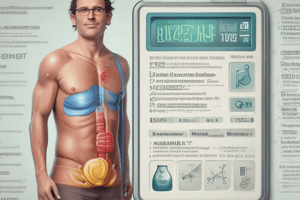Podcast
Questions and Answers
Why is it important to involve the patient and their family in the chemotherapy process?
Why is it important to involve the patient and their family in the chemotherapy process?
- They can prescribe chemotherapy drugs.
- They may have insights that affect treatment decisions. (correct)
- They can help administer the medication.
- They are responsible for monitoring side effects.
What is the typical nature of rheumatic chorea?
What is the typical nature of rheumatic chorea?
- It is chronic and progressive without recovery.
- It only affects children permanently.
- It usually resolves on its own with rest. (correct)
- It requires immediate medication for treatment.
What is the primary goal once an effective chemotherapy dose is established?
What is the primary goal once an effective chemotherapy dose is established?
- To continually increase the dosage.
- To maintain the dosage level. (correct)
- To switch to alternative medications.
- To decrease the frequency of administration.
How does limiting the chemotherapy dosage benefit the patient?
How does limiting the chemotherapy dosage benefit the patient?
In which situation is medication primarily needed for rheumatic chorea?
In which situation is medication primarily needed for rheumatic chorea?
How long should medications be continued in cases of rheumatic chorea?
How long should medications be continued in cases of rheumatic chorea?
What role does effective communication play in the chemotherapy process?
What role does effective communication play in the chemotherapy process?
What happens if the established dose of chemotherapy is not adhered to?
What happens if the established dose of chemotherapy is not adhered to?
What should be done after medications for rheumatic chorea show improvement?
What should be done after medications for rheumatic chorea show improvement?
Which of the following medications is NOT commonly used in the treatment of rheumatic chorea?
Which of the following medications is NOT commonly used in the treatment of rheumatic chorea?
Which of the following medications is considered a cannabinoid agonist?
Which of the following medications is considered a cannabinoid agonist?
What is the primary role of cannabinoid agonists like dronabinol and nabilone in treatment?
What is the primary role of cannabinoid agonists like dronabinol and nabilone in treatment?
Which of the following medications has shown promise in treating withdrawal symptoms alongside cannabinoid agonists?
Which of the following medications has shown promise in treating withdrawal symptoms alongside cannabinoid agonists?
Naltrexone is primarily used for which of the following therapeutic purposes?
Naltrexone is primarily used for which of the following therapeutic purposes?
Among the following, which treatment is NOT classified as a pharmacotherapy for withdrawal manifestations?
Among the following, which treatment is NOT classified as a pharmacotherapy for withdrawal manifestations?
Flashcards
Psychosocial Treatment
Psychosocial Treatment
A type of therapy that focuses on the interaction between psychological and social factors in mental health.
Pharmacotherapy
Pharmacotherapy
The use of medications to treat illness.
Cannabinoid Agonist
Cannabinoid Agonist
A type of medication that binds to cannabinoid receptors in the brain, similar to the effects of marijuana.
Withdrawal Reduction
Withdrawal Reduction
Signup and view all the flashcards
Promising Treatment
Promising Treatment
Signup and view all the flashcards
What is rheumatic chorea?
What is rheumatic chorea?
Signup and view all the flashcards
What is the typical course of rheumatic chorea?
What is the typical course of rheumatic chorea?
Signup and view all the flashcards
When are medications used for rheumatic chorea?
When are medications used for rheumatic chorea?
Signup and view all the flashcards
Establishing an effective dose
Establishing an effective dose
Signup and view all the flashcards
Effective dose
Effective dose
Signup and view all the flashcards
What is a medication used for severe rheumatic chorea?
What is a medication used for severe rheumatic chorea?
Signup and view all the flashcards
How long should medication for rheumatic chorea be continued?
How long should medication for rheumatic chorea be continued?
Signup and view all the flashcards
Limiting dosage to effective level
Limiting dosage to effective level
Signup and view all the flashcards
Patient and family involvement
Patient and family involvement
Signup and view all the flashcards
Dose adjustment
Dose adjustment
Signup and view all the flashcards
Study Notes
Practical course 1: DM
- Three types of insulin for basal blood glucose control are NPH BID, glargine OD, or detemir OD-BID
- Basal insulin injections control fasting glucose and suppress overnight hepatic glucose production.
- Prandial insulin controls post-prandial glucose spikes and is given with each meal.
- Three types of insulin for prandial blood glucose control are insulin lispro, insulin aspart, and insulin glulisine.
- Prandial insulin such as insulin glulisine starts working in 5-10 minutes and is given with each meal (SC)
- Regular insulin is considered pre-prandial because it takes about 30 minutes to start working.
- If a diabetic patient takes regular insulin just before a meal, it may lead to delayed insulin action, resulting in a spike in blood sugar levels after the meal.
Practical course 2: Endocrine emergencies
- The aim of giving insulin in a sliding scale is to reduce elevated blood glucose levels to a normal range.
- Giving correction insulin is the worst way to manage diabetes.
- Total daily insulin requirement for an 80 kg diabetic patient is approximately 40 units, divisible into 27 U morning and 13 U evening.
- Factors that increase insulin requirements include treatment with certain drugs, pregnancy and trauma.
- Factors that decrease insulin requirements include physical activity and reduced caloric intake.
Practical course 3: Contraception
- Triphasic combination preparations reduce the total amount of steroids and approximate the estrogen/progestogen ratios that occur during the menstrual cycle.
- Oral combined contraceptives inhibit FSH release to suppress follicle development
- Progestogen in oral combined contraceptives inhibits LH release to prevent ovulation, and increases cervical mucus viscosity.
- Disadvantages of oral contraceptives include irregular menstrual bleeding and headaches
- Common adverse effects of hormonal contraceptives include headaches, nausea, fluid retention, weight gain, breast tenderness, and changes in libido.
- Progestin-only pills do not inhibit ovulation, inhibit lactation, and do not inhibit the menstrual cycle.
Practical course 4: Obesity
- Indications for pharmacotherapy in obesity include BMI ≥ 30 kg/m² and BMI ≥ 27 kg/m² in the presence of obesity-related diseases.
- Orlistat is a gastric and pancreatic lipase inhibitor that decreases fat absorption.
- Liraglutide is a GLP-1 analogue that works by reducing caloric intake and increasing energy expenditure.
- Undeclared ingredients are pharmaceutical agents added to what are marketed as pure herbs
Practical course 5: Nutrition
- Curcumin improves insulin sensitivity.
- Ginkgo Biloba enhances cognitive function.
- Isoflavones support bone density, particularly in postmenopausal women.
- Lycopene is a carotenoid that reduces prostate cancer risk.
- Omega-3s reduce the risk of neurodegenerative diseases.
- Polyphenols are anti-inflammatory and antioxidant compounds that help inhibit cancer cell growth.
Practical course 6: Sleep Management
- Benzodiazepines stimulate specific BZ1 & BZ2 receptors, increasing GABA's affinity and increasing chloride ion channel opening, causing hyperpolarization and decreased neurotransmission.
- Unsatisfactory response to benzodiazepines may be seen in patients with a history of alcohol consumption.
- Benzodiazepines should be prescribed for the shortest duration possible to avoid psychological and physical dependence.
- Withdrawal symptoms from benzodiazepines can include anxiety, restlessness, confusion, insomnia, orthostatic hypotension and seizures.
Practical course 7: Pain & Drug Abuse
- The WHO analgesic ladder involves a three-step approach with nonopioid analgesics in the first step, weak opioids in the second step, and potent opioids in the third step.
- An opioid conversion table helps to shift between different opioids or formulations of the same opioid.
- Examples of analgesic adjuvants include tricyclic antidepressants (TCAs), serotonin-norepinephrine reuptake inhibitors (SNRIs), and anticonvulsants like gabapentin and pregabalin.
Practical course 8: CNS Emergencies
- Status epilepticus is classified into stages based on duration and response to treatment.
- Stages are: early, established, refractory and super-refractory.
- Antidepressants (SSRIs, TCAs) and bupropion increase serotonin synthesis and serotonin release.
- Dextromethorphan, ergot derivatives, and MAO inhibitors inhibit serotonin uptake and metabolism.
- Serotonin syndrome is managed by supportive care, discontinuation of serotonergic agents and using non-selective serotonin receptor blockers.
Practical course 9: IV Fluids
- Hypertonic electrolyte solutions distribute intracellularly and act as plasma expanders
- D5W (5% dextrose in water) is equivalent to pure water
- Isotonic saline is used to expand the extracellular fluid in hypovolemic patients, treat hyponatremia in hypovolemic patients or treat saline-responsive metabolic alkalosis.
- Hypertonic saline may be preferred over mannitol in head trauma for its magnitude and duration of ICP reduction and absence of rebound ICP.
- Lactated Ringer's will not act as a buffer in hypoxia
Practical course 10: Treatment of selected infections (Typhoid, UTIs, Rheumatic fever)
- The appropriate initial treatment for a 54-year-old female with UTI and suspected P. aeruginosa is carbapenems.
- Empiric therapy for a 13-year-old with suspected typhoid fever may include ceftriaxone.
- The first-line treatment for acute rheumatic fever is benzathine penicillin G.
- Educating patients about antibiotic prophylaxis for dental and other procedures to prevent endocarditis(valvular) is essential
Practical course 11: Treatment of selected infections (CAP & HAP)
- Alternative antibacterial therapies for community-acquired pneumonia(CAP) and hospital-acquired pneumonia(HAP), in the absence and presence of MRSA risk, and mortality.
- Common antibacterial therapies are: amoxicillin, doxycycline, clarithromycin or azithromycin
- Treatment duration for uncomplicated CAP is typically 5 days, while for CAP due to suspected or proven Pseudomonas or MRSA, it's usually 7 days
Practical Course 12: Treatment of selected infections (Meningitis)
- Appropriate treatment for suspected meningitis, typically involves initial treatment with antibiotics and dexamethasone.
Practical Course 13: Antimicrobial Prophylaxis
- Guidelines for classifying antibiotics as narrow or broad-spectrum and bacteriostatic or bactericidal are provided.
- Contraindicated combinations, when administering antibiotics, are stated.
- Non-antibiotic prophylaxis is usually required after neurosurgical procedures.
Studying That Suits You
Use AI to generate personalized quizzes and flashcards to suit your learning preferences.



